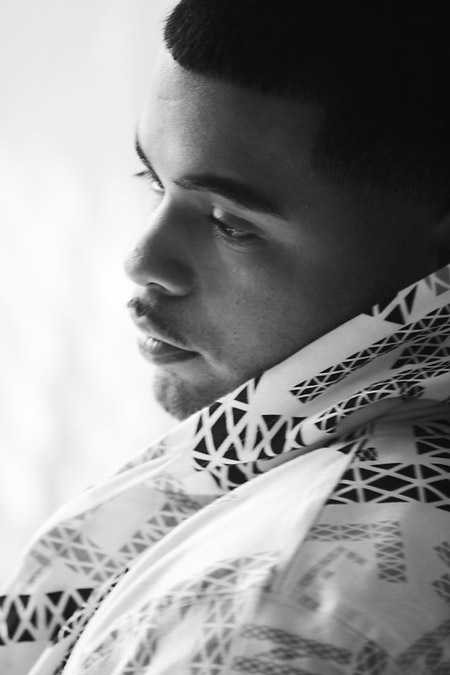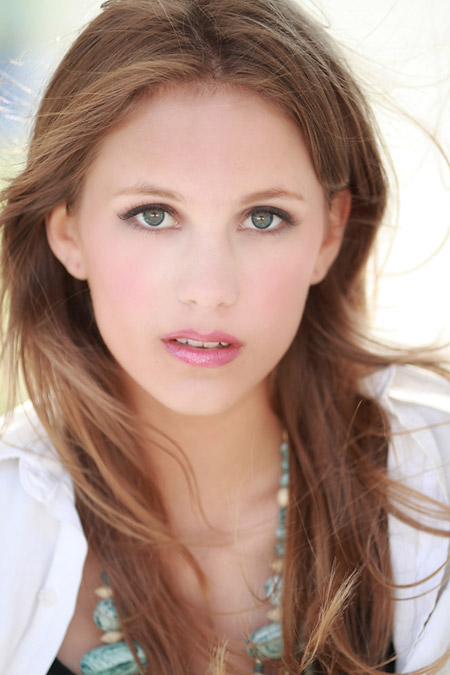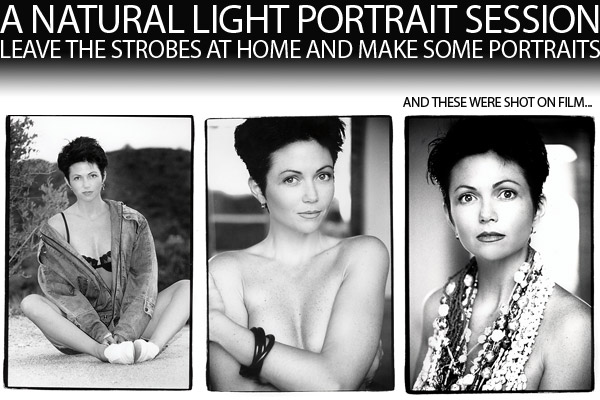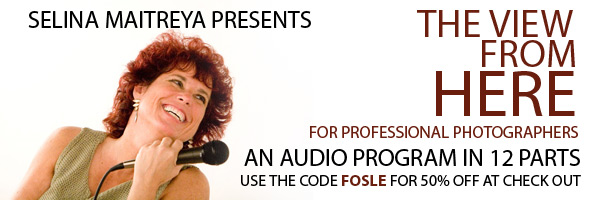Recently there was a discussion on whether natural light shooters would be able to compete with the strobe-heavy photographers and those deep into the Photoshop illustrative techniques. And before we begin it must be stressed that I love all kinds of photography. This is not ‘against’ any style that you may enjoy, it is only a look at some simple, and entirely wonderful ways of shooting.
Photography embraces all types of imagery. From the heavily illustrated work of Dave Hill and Tim Tadder, to the Photojournalist with a camera in a war zone, to a wedding shooter with a speedlight – and more. We love it all. I hope that when you look at a photograph you don’t measure it by whether it was ‘hard to do’ but whether it speaks to you and makes its way into your inner vision. The image is what is important.
The discussion was at Heather Morton’s excellent blog. Jaimie said:
“The other post I wanted to mention was the ‘To Gear or Not To Gear’ article where there was a discussion about exactly that. I think this was actually the first compliment I think I’ve received from someone in the industry in regards to my natural light stuff. I guess I’m curious to know why it’s seen as such a bad thing. I completely understand that in the advertising world it’s all about control and customization as well as being a little over the top in many cases. What I don’t understand is why working with natural light seems to be frowned upon and/or viewed as being amateur and simplistic, or something that wasn’t thought out. Seriously, I don’t think either Grant or I or any other shooter that uses a lot of available light (Chris Wahl anybody?) are just taking our cameras outside and hoping for the best when we shoot.”
I think that is something that a lot of people who first get interested in photography through the internets think. Unfortunately. And of course the marketers abound with gear gear gear to a point where some would wonder if were even possible to create images without a ton of lights. And of course it is. And shooters like Frank Hoedle use a lot of gear to achieve a look that seems more natural than not. And this is NOT a gear discussion…
This is a possibilities discussion. I have no dog in the hunt as they say. I could care less what anyone shoots with or without… just show me the pictures. Do they move me? Good.
My post today is on simplistic shooting… just a camera and a subject. The images above were taken 25 years ago. (Natural light, Nikon F3, 180MM f2.8 Nikkor @ 2.8, on Tri-X at ISO200 and pushed 15% in D76.) They were taken in Scottsdale, AZ on a bright, sunny day. There are no fill cards or any other lighting gear used. I think they work.
Why? Because it doesn’t matter to the image. The subject connects with you instantly. The light is subtle and soft and inviting. Was it ‘easy’? I don’t remember most anything being ‘easy’. The location has to work, and then there are considerations to be made. Will the light ‘work’ or will it just be exposure light? Can I sculpt the subject a bit and separate her and emphasize the line and shape and flow? What exposure compensations may I have to make to create on the film or capture, the look I see in my head? The only thing that is easy is that I only had to carry my bag to the shoot.
In the shot on the right we were in a closed in patio with a large window facing south. The light coming in that window was shaded from direct sun by an overhang, so the light was soft and wide. Placing the subject into that light and then making sure the walls were lit enough to provide the soft edge lighting was the goal. We had to move some furniture to get it right, but we did. Same location for the shot in the middle, and as the sun went behind a mountain and left us in shade, we did the shot on the little gravel driveway.
I shoot to the right and process to the left. What that means is I would more likely over expose the image and process to the shadows than I would underexpose. I like brighter skin tones and I like a neg or capture that has some contrast to it. Digital is so flat compared to film. So I shot the film to the regular ISO200 that I usually did (Tri-X was rated at ISO 400… yeah, and I am the king of prussia) and pushed the film (over developed it) to get a bit more contrast. Digital to follow after the jump.
This kind of shooting was my style back then. Natural or slightly modified light. Natural looking subjects in natural settings. I still love that look and shoot it. An older post on shooting with nothing but available light, Minimalist Shooting, is here and features my friend Christina.
BTW… if you would like one of those hand-filed negative borders, here you go. Just put the image in a layer below the border. This is one of my own filed negative holders, so enjoy. Only available here, and may not be available forever.
The shot below was made in Houston at a workshop. I noticed the light coming in from the window and knew it would be a nice light for a portrait. Moving the subject into the light, I made an exposure reading for his cheek and stopped down one stop from the reading. I wanted a darker side to me, and if I had exposed to the meter, the cheek would be one stop brighter, and the highlight of the face blown to nothing. I like the feeling of the light in shots like this… almost feel the warmth.
I could have brought a fill card in to lighten the shadows even more, but I liked the overall look of this shot so I left it out.

The next shot was taken in Seattle, also at a workshop. Behind me is a large white building which is adding some huge, soft light to the subject. I love the natural catch lights in the eyes when shooting natural light. This shot was taken with a Canon, 70-200MML f2.8 @ 2.8, ISO 100. Zoomed almost all the way out, the limited DOF is just delicious. There is no additional lighting modifications added to this shot.
The subject is under an awning, and the light is bouncing all around from a bright, sunny day around the structure. Keeping her in line with the brighter background helped her stay “open”, with a feeling of surrounding light that envelops her. Note that the brighter background objects out of frame are presenting as rim and hair light. Subtle, but then subtle is pretty cool to me.

For exposure: I metered the shot with an incident meter (Minolta IV) and it gave me a reading of 2.8 @ 1/320. And that would have been fine. But I chose to over-expose the image (1/200) to make sure I got the skin tones up and captured all the shadow detail I wanted. At post I can take it down if needed, but in this case the image was fine in post. Only a slight modification was needed to enhance the contrast.
What I would like you all to do, is just experiment a little with some minimal gear. Try making shots with only a subject and a lens. Find locations that have some amazing light falling all around and use it to create images that seem to have more light sources.
Here are some photographers that may inspire you to try some natural light, or minimalist shooting.
Nick Onken
Kate Orne (Women section – may be NSFW)
Jaimie Hogge
Grant Harder
Dave Hill (yes, THAT Dave Hill)
Jeff Petry
Mark Tucker
Nadav Kander (Dig around in the work a bit)
Peggy Sirota
Arthur Elgort (Especially Fashion: Check the ballet shots as well)
Chris Wahl
Of course all of the photographers mentioned above know their way around a strobe kit, and they all do work with lighting. There are images in their portfolio that use lighting… some use LOTS of lighting. The point I am making is that they also create compelling images with minimal equipment.
And that means that compelling photographs are available to the shooters who flex their lighting muscles and create with what they have. MAKE the shot happen. Take a subject out and take your cameras. MAKE the shot happen. Just for a while, focus on what you have on hand… what the light is doing, what you can do with it, where it is advantageous light, and where your image can be what you see in your head.
MAKE the shot happen. No excuses. Treat it as an assignment. You MUST make a compelling image.
I am thinking about doing some posts on the Medium Format film cameras. That way when you rent one, and you should, you will have the info here to get started right away. Your comments?
Thanks for taking this little rant about minimal shooting with me. Follow me and get all kinds of photographic links at Twitter. See you next time.







Great post, Don – love the info, the reflection of what makes images work. People need to keep hearing that it isn\’t the gear that makes/takes/creates the image.
I look forward to your post on MF – interesting to see this as a trend right now in photography blogs.
Amen Don, photography is subject and concept centric it shouldn´t be measured by the kind of gear (hot shoe strobe, hot lights, studio lights, etc.) because it should be measured by the end result… A good photographer should be able to manage natural light, artificial light, the mix of both, etc. because it is the concept what´s relevant.
K.I.S.S. is an approach overlooked in favor of hyped post processing tutorials, hyped lighting setups (regardless if it fits in the concept and makes justice to the subject) and other copycat hyped things that end in things that are awkward in the end sometimes simple is better.
Beautiful examples and great list of shooters too! thanks Don!
Keep rocking!
Eduar
Thank you so much for writing this article. I am looking to take my photography to the next level and go pro and one thing I would like to specialize in is natural light photography. I really like the look of natural light photography. Can you recommend any resources where I can read more on natural light photography?
Great post Don. Love the first set of images. This post is a reminder that it is all about making the shot happen with whatever light is available or required by the client. I never have understood why some photographers limit themselves to ‘natural light’ or more speedlights then a minivan has cup holders. It feels strange to go on a shoot with only a reflector and diffuser but it can be a refreshing and rewarding experience. A post on medium format would be most welcome.
an awesome post.. thanks for sharing
After many years of on/off photography with film cameras I had my first serious play with digital the other weekend. I borrowed a friends Nikon and took a couple to a alleyway to do some portraits. The lighting was primarily overhead with the sky quite cloudy. Learning to really look at what the top light was doing and how it shaped the face really made me stop and think. Although we had some flash units with us the best tool was a home made reflector from rip stop nylon (sunbounce impersonation). The natural light was soft and flattering to the female yet retained the masculine look for the male. Gear is simply stuff to carry. Natural light is free and learning to use it properly is a wonderful challenge. Getting exposure spot on in camera is the real art, not post processing.
Love your posts, they present a good balance and challenge us all to constantly look at both our techniques and motives. Keep up the great work.
Great Post Don,
Would love to hear all you have to say about film.
I have a MF camera, but its just so easy to pick up the digital when you want it now. However, its always a pleasure when I get my transparencies back. It just has that timeless look about it.
Have to confess, sometimes when I shot film, (with strobe) I’ll chimp with the digital, but then, that what Polaroids were for right?
Great work!
Great article. I think a lot of people get into photography as typical snapshot shooters (not everyone, but many) and as skills improve there is this feeling that real photography is all of the gadgets. I prefer natural light or minimal use of flash. I am, however, looking forward to taking one of your lighting essentials classes (that is how I happened upon this article). I figure the more I can learn about lighting the better I will get with my natural light or minimalist flash photography. Actually, I have been thinking of dusting off my 35mm SLR and going bact to basics, film, at least for one roll.
Thanks
And you will find in my lighting essentials workshops that I am all about lighting… not about gear. Great use of light – from natural to strobe to mirrors to whatever. I teach “Subject Centric Lighting” – in other words, what do you want the subject to look like, then decide on the tools that you want to use.
Great article. Some people use flashes to create a WOW shot much like shallow DOF, fisheye, HDR or any other special effect can be used. These effects are useful parts of photography but shouldn’t necessarily be the main focus. I don’t enjoy setting up lights so usually I don’t even bother. Natural light is amazing the trick is being able to harness it because it’s not always predictable and it’s not always enough. I’d like to be using more flashes but at the same time I also want to find better ways at harnessing what’s already out there.
Great stuff and book also , I myself is struggling with lighting , I am in this mindset that you need alot of equipment and this proberly why i don’t shoot alot now , I will do alot thinking now about Natural Light , and also two other drawback do you need a view camera or anything larger than 35 mm , I seen lots of great shots with large format and meduum format , some only with 35 , I shoot with film and digital
No, you do not need a lot of gear to make good photographs. Just shoot and shoot and shoot. I use very little gear. If you hit the home page today, you will see a downloadable book shot almost entirely with simple gear… really only one body and two lenses. Natural light, strobes and more. Keep it simple. Keep it yours.
Curious: When I look at the heavily illustrative work of this or that pro shooter, who, as a rule, is performing the heavy illustrative work? The photographer? Or a team of post-processing digital artists? Just curious.
After reading this article, I decided to unpack the Mamiya 645 and a ton of film and my light meter and just get out to shooting with just a subject and available light. It was a blast. Images look stunning to boot. Great advice here. There’s a time to get back to basics and simplicity for all of us.
I consider it another part of my repertoire at every shoot. I use my light, I use ambient light. I like the very shallow depth of field that is hard to get using a strobe. Thanks for posting this Don. There are many that get locked into one style or other. The “Only Shoots Ambient Light” crowd and the “Only Strobist Crowd” and there is nothing wrong with either of them, but it is far more liberating to change on the fly, use the light, enhance the light and over power the light to get the variety and creativity I need.